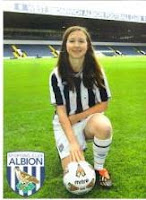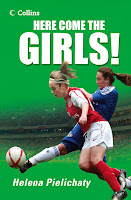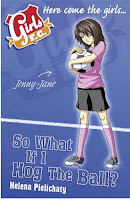I’m delighted to be the first contributor to this exciting new blog, especially as the timing coincides with so many significant events such as International Women’s Day (March 8th), World Book Day (March 7th) and the 125th anniversary of the Football League (1888–2013). I can’t think of three things closer to my heart than celebrating equal rights for women, books and football, so my blog is going to combine all three strands.
Let me start with a true story. On a chilly Saturday morning in March 1995, I was standing with my husband on the touchline of a primary school’s football pitch in Newark, Nottinghamshire, watching an inter-schools U11s match. The bloke next to me had been growing more and more agitated at his son’s performance. Finally, after the boy was, once again, skinned by the ten-year-old girl he was trying to mark, the dad snapped. ‘What are you doing, Jason, you useless lump! How can you let a lass tackle you like that? What’s wrong with you?’
‘Nothing’s wrong with him,’ I said, ‘it’s just that the girl is very good.’
‘But that’s just it: she’s a girl!’

The bloke was fuming, clearly disgusted at this world gone mad – so much so he stormed off, preferring to sit the rest of the match out in his car than on the pitch.
I’ll never know what happened to Jason, but I do know that the girl, my daughter, Hanya (pictured left, at West Bromwich Albion Ladies), would go on to play football at high school, at university, for her county and at senior level for many years to come.
I thought of that incident while researching the early development of the women’s game for the opening chapter of Here Come the Girls for Collins Read On!

I was reading through historian Patrick Brennan’s website, studying his section on the trailblazing British Ladies FC.I already knew that the BLFC had been founded in 1895 by Nettie Honeyball and were an attempt by Honeyball and other members of the suffragist movement to show that: ‘women were more than mere ornaments.’

I also knew that the ‘Lady Footballers’ caused quite a stir and played over a hundred exhibition matches up and down the British Isles. What I didn’t know, until I read the appendix, was that one of those matches had taken place at Newark Town FC’s ground, not a mile from where I’d watched Hanya play.
I went to the library to track down the original match report and was amused to discover that the spectators then were a lot less hostile to girls playing than Jason’s dad appeared to be, a century later. The one-thousand strong crowd: ‘… no way resented the infringement perpetrated by the fair ones in donning semi-masculine attire.’ In your face, Jason’s dad!
Unfortunately other towns gave the British Ladies a much harder time, mocking them for ‘aping’ men and daring to even think they could play football. In Ayrshire, Scotland, a month later, for example, there was: ‘… quite a little riot. One of the ladies got a black eye from some ruffian, the crowd of savages broke in, and the players would not go on.’
Progress is evident at senior level, too. The England FA has finally started investing in the women’s game and in 2011 the Women’s Super League, featuring players paid on a semi-professional basis for the first time, had its inaugural season. To nurture future talent in the same way as men’s clubs do through boys’ academies, there are thirty-one Girls’ Centres of Excellence and a firm player pathway at grassroots level.
There’s been progress in the media, too. In 1995 you would have struggled to find anything about women’s game but now key international matches are shown on TV and the results reported in most papers.
Although attendance invariably and inevitably lags behind that of men’s matches, for the final of the women’s football event at the London 2012 Olympics, a whopping 80,203 crowd turned out to see USA beat Japan 2-1. Girls even have their own bespoke football magazine, She Kicks and there are several websites dedicated to the women’s game. It’s not all hunky-dory, though.

Sexism is never far from the surface as this recent piece in the Peterborough Times from February 22nd illustrates, calling ladies’ sport ‘dull’. There’s a way to go in other countries, too. I dedicated one of my Girls FC titles, So What if I Hog the Ball?, to Eudy Simelane, captain of the South African Women’s football team, who was brutally murdered in 2008 for being openly gay.
But let’s not dwell on the negatives. Let’s celebrate World Book Day by reading about women in sport. Let’s celebrate International Women’s Day by paying homage to Nettie Honeyball, Eudy Simelane and many, many more men and women who’ve made it easier for girls today to compete at the highest level in their discipline all over the world. Last but not least let’s celebrate the 125th anniversary of the League because football rocks!


